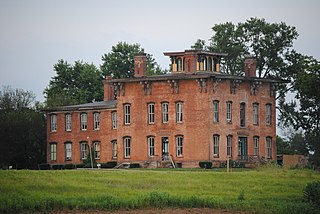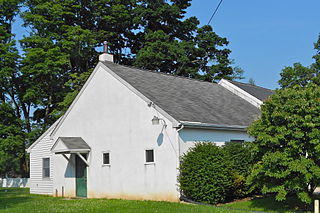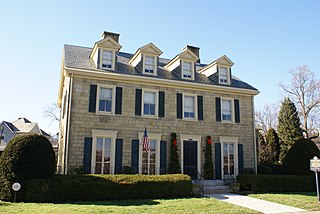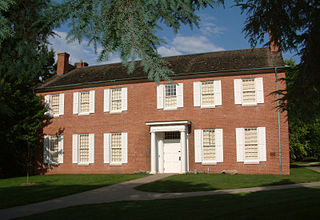
Muskingum County is a county located in the U.S. state of Ohio. As of the 2020 census, the population was 86,410. Its county seat is Zanesville. Nearly bisected by the Muskingum River, the county name is based on a Delaware American Indian word translated as "town by the river" or "elk's eye".

Zanesville is a city in and the county seat of Muskingum County, Ohio, United States. Located at the confluence of the Licking and Muskingum rivers, the city is approximately 52 miles (84 km) east of Columbus and had a population of 24,765 as of the 2020 census, down from 25,487 as of the 2010 census. Historically the state capital of Ohio from 1810 to 1812, Zanesville anchors the Zanesville micropolitan area and is part of the greater Columbus-Marion-Zanesville combined statistical area.

Marietta is a city in, and the county seat of, Washington County, Ohio, United States. It is located in southeastern Ohio at the confluence of the Muskingum and Ohio Rivers, 11 miles (18 km) northeast of Parkersburg, West Virginia. As of the 2020 census, Marietta has a population of 13,385 people. It is the principal city of the Marietta micropolitan area, which includes all of Washington County, and is the second-largest city in the Parkersburg–Marietta–Vienna combined statistical area.

John Rankin was an American Presbyterian minister, educator and abolitionist. Upon moving to Ripley, Ohio, in 1822, he became known as one of Ohio's first and most active "conductors" on the Underground Railroad. Prominent pre-Civil War abolitionists William Lloyd Garrison, Theodore Weld, Henry Ward Beecher, and Harriet Beecher Stowe were influenced by Rankin's writings and work in the anti-slavery movement.

Thomas Garrett was an American abolitionist and leader in the Underground Railroad movement before the American Civil War. He helped more than 2,500 African Americans escape slavery.

Prospect Place, also known as The Trinway Mansion and Prospect Place Estate is a 29-room mansion built by abolitionist George Willison Adams in Trinway, Ohio, just north of Dresden in 1856. Today, it is the home of the non-profit G. W. Adams Educational Center, Inc. The mansion is listed on the National Register of Historic Places and the Ohio Underground Railroad Association's list of Underground Railroad sites.
The Pioneer and Historical Society of Muskingum County, also known as the Zanesville Historical Society, is an organization located in Zanesville, Ohio, in the United States, with the mission of preserving the history of the Zanesville and Muskingum County region of Ohio. It is a non-profit entity which operates several important historic sites in and around the Zanesville, Ohio, area, including the Dr. Increase Mathews House, built in 1805 by a founder of the town; and the Stone Academy, erected in 1809 as a possible state capitol, which was also a meeting place for abolitionist societies, and once the home of writer Elizabeth Robins, who wrote about it. The Pioneer and Historical Society of Muskingum County received a Preservation Merit Award from the Ohio Historic Preservation Office Award in 1993 for its work restoring and preserving the Stone Academy.

The Friends Meetinghouse is an historic Friends Meeting House of the Religious Society of Friends (Quakers) located at the junction of Routes 146A and 98 in Uxbridge, Massachusetts. On January 24, 1974, it was added to the National Register of Historic Places.

Ercildoun, population about 100, is an unincorporated community in East Fallowfield Township, Chester County, Pennsylvania, United States. The hamlet was founded by Quakers and was an early center of the abolitionist movement. In 1985 the entire hamlet, including 31 properties, was listed as a historic district on the National Register of Historic Places. Of these properties two were vacant land, 14 were significant buildings, ten were contributing buildings, and five buildings, built in the 1950s, were non-contributing. The Lukens Pierce House, an octagon house listed separately on the U.S. National Register of Historic Places, is located about half a mile northwest of the hamlet. Ercildoun is one of about ten hamlets in the township, which has no cities or towns, but has 31 sites listed on the National Register. It is one of the larger hamlets, located near the center of the township, and historically among the best known. The city of Coatesville is about 3 miles north.

The John Street House is a historic home in Salem, Ohio. It was a stop on the Underground Railroad.

St. James AME Zion Church is a historic African Methodist Episcopal Zion church located at Ithaca in Tompkins County, New York. It is a two-story, frame church structure set on a high foundation and featuring a four-story entrance tower. The church structure was begun in the 1830s and modified many times since. The original stone meetinghouse was built in 1836 and is believed to be Ithaca's oldest church and one of the oldest in the AME Zion system.

The Putnam House is a historic building in the Harmar neighborhood of Marietta, Washington County, Ohio, United States, on the National Register of Historic Places. The house overlooks the Muskingum River.

Mechanicsburg United Methodist Church is a historic Methodist congregation in the village of Mechanicsburg, Ohio, United States. Founded in the early nineteenth century, it is the oldest church in the village, and as such it has played a part in the histories of other Mechanicsburg churches. Its fifth and present church, a Gothic Revival-style structure erected in the 1890s, has been named a historic site.

Beecher Hall is the oldest building on the campus of Illinois College in Jacksonville, Illinois. Built in 1829–30, it was the first college building erected in the state of Illinois. The building has served many functions for Illinois College, including housing the first medical school in Illinois in 1843. It is named after the first president of Illinois College, Edward Beecher. Beecher Hall is recognized by the National Park Service as being a stop on the Underground Railroad. The building is listed on the National Register of Historic Places.

Beecher Bible and Rifle Church is a historic church at the southeastern corner of Chapel and Elm Streets in Wabaunsee, Kansas. The church is named after Rev. Henry Ward Beecher, a financial backer for the town who helped smuggle rifles past pro-slavery forces in crates marked Bibles.

Alan West Corson Homestead is a historic house located in Whitemarsh Township, Montgomery County, Pennsylvania. It was built in three sections between 1734 and 1820. It is a 2+1⁄2-story, stuccoed stone dwelling, six bays wide and two bays deep. It has a 2+1⁄2-story rear ell. Also on the property is a contributing smoke house. The property was used for one of the earliest area nurseries and a boarding school.

The Hovenden House, Barn and Abolition Hall is a group of historic buildings which are located in Plymouth Meeting, Whitemarsh Township, Montgomery County, Pennsylvania. In the decades prior to the American Civil War, this property served as an important station on the Underground Railroad. Abolition Hall was built to be a meeting place for abolitionists, and later was the studio of artist Thomas Hovenden.
The Ohio Anti-Slavery Society (1835–1845) was an abolitionist Anti-Slavery Society established in Zanesville, Ohio, by American activists such as Gamaliel Bailey, Asa Mahan, John Rankin, Charles Finney and Theordore Dwight Weld.

Marius Robinson (1806–1878) was an American minister, abolitionist, and newspaper editor of the antislavery newspaper The Philanthropist and The Anti-Slavery Bugle. He helped establish a school for African Americans in Cincinnati, Ohio while attending Lane Seminary. Responding to backlash from the city's residents, he continued to teach and was one of the Lane Rebels who would not be pressured to give up improving the lives of African Americans. He was an anti-slavery lecturer. He worked together with his wife Emily Rakestraw Robinson, to better the lives of African Americans.


















